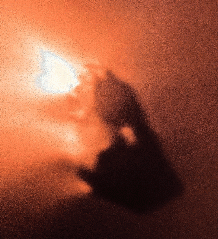
Nucleus of Comet Halley from Giotto
| The Cometary Nucleus |
|---|

The Nucleus
The solid, centrally located part of the comet is known as the "nucleus". The nucleus is a repository of dust and frozen gases. When heated by the sun, the gases sublimate and produce an atmosphere surrounding the nucleus known as the coma which is later swept into the elongated tail.
Size
The sizes of cometary nuclei are mostly unknown because the measurement is a difficult one. We have reliable measurements of the sizes of about 10 nuclei. Most of them have diameters from a few km to 10 or 20 km. The nucleus of comet Schwassmann-Wachmann 1 is probably one of the largest (perhaps 20 km), as is the nucleus of comet Hale-Bopp (perhaps 40 km). Except in the special cases of comets Halley and Borrelly, whose potato-shaped nuclei were resolved by the cameras of passing spacecraft, the sizes are inferred.Composition
The composition of the nucleus is determined by measuring the composition of the coma. We know nothing directly about the interior structure. The dominant volatile is water, followed by CO, CO2 and a host of minor species present at the <1% level. There is some evidence for abundance variations among comets. The CO/H2O ratio reached 0.2 to 0.3 in Hale-Bopp but is typically 4 or 5 times smaller.The refractory (non-volatile) dust consists of some silicate minerals and carbon rich CHON (Carbon-Hydrogen-Oxygen-Nitrogen) grains. The upper layers of the nucleus are volatile depleted, consisting of a refractory "mantle".
The ratio of volatile mass to refractory mass is probably near 1.
Lifetime
The lifetimes of active comets are limited for at least two reasons:
First, the nuclei are losing mass at rates that cannot be sustained for very long. For example, a 5 km radius spherical nucleus would have a mass about 4x10^15 kg. When near the sun, this nucleus might sublimate at 10^4 kg/s (10 tonnes per second), so the sublimation lifetime is 4x10^11 s = 1000 years. True, the comet might spend only part of each orbit near the sun, and so might be able to keep going for more than 1000 years, but it is simply unable to sustain mass-loss for the 4.5x10^9 year age of the solar system.
Second, the active comets are under the gravitational control of the planets. There is a finite chance that a comet will be either ejected from the solar system, injected to the sun, or absorbed by an impact with one of the planets (as happened in the famous case of Shoemaker-Levy 9). The "dynamical" lifetime of a typical comet is about 1/2 million years.
Given that the comets we see now cannot have been present in the inner solar system for more than a million years or so, we have two choices. Perhaps the comets are young, meaning that they are created somewhere and then dumped in the inner solar system where they become active and are discovered. The trouble with this is that we do not see any place in the solar system where comets could be formed at the present time. So, it seems more reasonable that the comets were formed with the rest of the solar system and have been stored since formation in a cold place where the nuclear ices would be stable. The two deep-freeze locations now under discussion are the Oort Cloud and the Kuiper Belt.
Last updated Apr 2003

| |
| Comet | Jewitt |
|---|